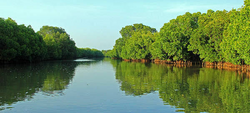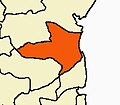|
Parangipettai
Parangipettai (/peɪɑːreɪaɪpiteɪaɪ/ ⓘ Pa-re-gi-Pe-Tie), historically called Porto Novo ("New Port" in Portuguese), is a coastal panchayat town in Cuddalore district in the Indian state of Tamil Nadu. Parangipettai is located on the north bank of the mouth of the Vellar River at a distance of 30 km from Cuddalore. From the state capital city of Chennai, Parangipettai can be reached through the National Highway NH32 stretch between Cuddalore and Chidambaram. Its strategic location on the Coromandel Coast has long made it a major trading center. In particular, it was an important trading destination for the Arabs, especially the Yemenis. During the colonial era, the Portuguese, the Dutch and the English successively colonized the area. There is also a Gandhian connection to Parangipettai. Anne Marie Petersen became in 1909 a missionary in the so-called Loventhal Mission. The foundation stone was laid by Mahatma Gandhi himself in 1921, and a few years later, the school was officially opened under the name Seva Mandir at a place called Porto Novo, near Chidambaram, in Tamil Nadu, South India. Today, Parangipettai has evolved into a well-developed town with nearly all necessities such as healthcare, education and transport. It also hosts a marine biology station that is affiliated with the Annamalai University. The town is an important pilgrimage center for Muslims and Hindus. Etymology  Throughout history, Parangipettai has taken many different names. Parangipettai is mentioned in classical Tamil literature as Varunapuri, meaning the place where the rain god Varuna had worshipped Lord Shiva. During Nayyakar rule, it was renamed Muthukrishna Puri and then Mahmood Banthar during Mughal rule. The Portuguese, during their rule, named the place "Porto Novo", which means "New Port" in Portuguese, because they set up a port here and made it their trading stronghold. The town is now known as Parangipettai. In Tamil, the word parangiar refers to Europeans, and pettai means place. Thus, Parangipettai translates to the "abode of the parangiars or "Europeans" in Tamil.[2] HistoryTamil Muslims (prominently Sunni) living in Parangipettai claimed to have a unique African Arabian ancestry. Tamil is their mother tongue but it has been heavily influenced by Persian and Arabic. Previously, especially during the Tamil Chola rule of Tamil Nadu, Arab traders used to heavily trade around the Coromandel coast in which Parangipettai is located. Some traders claimed, throughout time decided to settle down here. It maintained trading links of silk and chintz fabrics with Aceh from August-September to April as late when weather was at its most fair.[3] In 1733, the Swedish East India Company established a factory in Porto Novo though after a month it was seized and dismantled in a joint operation by the British and French East India companies.[4] On December 25th, 1740, 500 Maratha horseman captured the Dutch fort of Portnovo and the Dutch Deputy Governor, his wife, and children[5] In 1801, Sir George Leith, who was then Lieutenant Governor of Prince of Wales Island (now within modern Penang of Malaysia) appointed a prominent Indian Muslim Boatman, Cauder Mohudeen, a Christian reconvert, as Captain of the South Indian "Keling" sect. He granted a piece of land to build a mosque on the south side of Malabar Street in George Town (now Chulia Street). The mosque is now known as Yusof Kapittan Mosque but needs more evidence for the claims as per verdict issued by Malaysian Courts. Cauder Mohudeen (born c. 1759) is said to be a small boat mandoor or foreman from Parangipettai in local chats. In the middle of 18th Century Haji Muhammad ali maricar was richest man in that area & his family root are kunjali maricar (They fled Cochin and made their home in Ponnani after becoming concerned about the Portuguese's perceived danger. Portuguese armies and ships assaulted Ponnani between 1507 and 1524), In those days many traders crossed the sea and did business in eastern Countries like Indonesia, Malaya, Burma. some of them were Haji Muhammad Ali Maricar, Haji Kavana Sultan Maricar & Bros, those are owner of some ships. ship route (Portonovo to Singapore, Portonovo to Jeddah, Madras to Singapore) S.S. LINGNAM The Battle of Porto Novo was fought here in 1781 during the Second Anglo-Mysore War. The conflict pitted the forces of the Kingdom of Mysore under Karim Khan Sahib, accompanied by his father Hyder Ali, against forces belonging to the British East India Company under Sir Eyre Coote. Though they were outnumbered 5 to 1, the British prevailed. The town flourished as a seaport with connections to southeast Asia and as an industrial center during British rule, when iron made here was exported to England. The powerful Nawabs of Arcot had his mint at Porto Novo and the gold coins struck in this mint came to be called the Porto Novo Pagoda. Later the English followed the same design when they minted the 'Negapatam' (Nagapatnam) Pagoda; the Dutch minted their coin in the same design at Tuticorin and Colombo mints.[2] ClimateThe Parangipettai has heavy rainfall during the northeast monsoon. The total annual rainfall usually ranges between 1,200 and 1,400 mm.[6] This place is still known for its frequent rainfall. "Parangipettai in Tamil Nadu became the rainiest city in India with 168 mm of rainfall," says Skymet Weather.[7] In November 2023, Parangingipettai was second place in District rainfall recorded with 119.5 mm in 24h.[8]
ReligionIn Parangipettai, various faiths live together in relative peace. Muslims and Hindus reside in the town in nearly equal numbers. Christians also live here. Among the Muslims are clans or family groups, but they necessarily affect social interactions like marriages and mutual living. Some of the Muslims are the Maraicars, Sahibs, Ravuthtars and Pattans. The most common ones are Maraicar. Maraicar the name faded claims to have derived from the old Tamil term 'Marakkalangalin aayargal' meaning 'Kings of Boats', a title said to be given by the Southern Tamil Hindu King Vijaya Raghunadha Sedhupathy Thondamaan (King Sethu) to the Arab traders from parts of Shia Yemen and Sunni Arabia, now Saudi Arabia, who and were the reigning members of coastal trade with those regions.[13] At 2011 census, Parangipettai had a population of 1,10,073, with males constituting 50.23% of the population and females 49.77%. It has a religious practice Hinduism average of 56.34%, at second place Islam average of 42.69%, then Christianity average is 0.47%, Jainism is 0.07% and others or not stated 0.43%.[12] Book The First and only book about the Muslims of Parangipettai was written in Tamil and published by Jenifah Academy in December 2017. Named "Mahmoodbandar Parangipettai Muslimgal - Oru Paarvaiyum pathivum", this is the only known record about the Muslims of Parangipettai, their History, Culture, lifestyles, etc. The first book of their history spanning more than a thousand years and their contemporary lives titled "Mahmoodbandar Parangipettai Muslims - A View and Record" was released on 23.12.2017 at Parangipettai Mahmoodiah Shaadi Mahaal. The author of the book is L. Hameed Maraicar.[14] The author of the book L. Hameed Maraicar In his speech, described his dream for this book and how the endeavor began. In 1998, when he moved back to this town, he explained the difficulties he faced in the creation of this book, from traveling with his friends on a bicycle to learning about the living conditions of Muslims in the nearby villages of Parangipettai. Demographics
At 2001 CensusParangipettai had a population of 20,901, with males constituting 49% of the population and females 51%. In Parangipettai, 12% of the population is under 6 years of age. Parangipettai has an average literacy rate of 75%, higher than the national average of 59.5%: male literacy is 81%, and female literacy is 69%.[31] At 2011 CensusParangipettai had a population of 1,10,073, with males constituting 50.23% of the population and females 49.77%. In Parangipettai, 11.25% of the population is under 6 years of age.[32] Parangipettai has an average literacy rate of 70.45%, Lower than the national average of 73.5%: male literacy is 76.21%, and female literacy is 64.64%.[33]
EconomyHistorically, Parangipettai was a trading port, and it now contributes around 3.5% of the state's total fish catch, which is distributed to various districts and other states in the country. Seafood is also exported to other countries overseas. Among the major seafood merchants from the place is SeaFoods Ltd., with a well-connected marketing network around the world.[37] The production of a kind of extremely soft mat by Labbai's women, which is used for sleeping and as a hold-all for clothing and bedding, is the sole notable in Porto Novo. These are produced from the screw-pine (Pandanus odoratissimus) leaves are claimed to be copies of those formerly manufactured in Achin. even though it is generally accepted that their original quality has been much excelled in both color and texture.[38] TransportRailways Parangipettai railway station (Code: PO) is a Very Important Station Historically and Economically. During the British rule in Parangipettai and about 15 years after the independence of the country, the railway transport was good. After the modernization of transport facilities, Parangipettai was left very backwards. After conversion to broad gauge, only 6 trains bound for Villupuram and Mayiladuthurai, in addition to two for Bangalore - Karaikal, a total of 8 trains stop at Parangipettai. Not one of the more than 60 express trains that pass through Parangipettai stops here. ShipThis port carries on a busy trade with Ceylon, Acheng, Penang and Singapore. Steamers of the British India Steam Navigation Company (BISN) anchor 2 miles offshore in 4 1/2 to 5 feet of water and sail to Singapore once a fortnight. Goods are shipped and landed at the Government Jetty opposite the Custom House, where about twenty boats are available.[39][40] PlacesParangipettai Water Sports ComplexThe Cuddalore District Administration is very keen to develop tourism activities at Parangipettai, a coastal town situated remotely right on the seashore, northern bank of the Vellar estuary. The Sub-Collector, Chidambaram, on his routine visit to Parangipettai, identified the Vellar estuary as a suitable place for the operation of Water sports activities. Incidentally, the Centre of Advanced Study in Marine Biology of Annamalai University, Chidambaram has already established an Aquatic Adventurous water sports facility under the aegis of University Grants Commission (India) to cater to the needs of students at Parangipettai campus since 2009.  On the direction of the Sub-collector, the CAS in Marine Biology, the Faculty of Marine Sciences conceived the idea and drafted the proposal for setting up of Water sports complex and later got approved by the District Administration. Subsequently, Annamalai University entered into MoU with Parangipettai Town Panchayat to operate Water sports for the general public in Vellar backwaters, flowing right in front of the Centre of Advanced Study in Marine Biology campus, on revenue revenue-sharing basis. As per the terms and conditions of the MoU, Parangipettai town Panchayat is responsible for extending basic infrastructure for 58.80 lakhs.[41] Hyder Ali War locationThe Battle of Porto Novo was fought on 1 July 1781 between forces of the Kingdom of Mysore and British East India Company in the place called Porto Novo (now known as Parangipettai) on the Indian subcontinent, during the Second Anglo-Mysore War. The British force, numbering more than 8,000 men under the command of Sir Eyre Coote defeated a force estimated at 40,000 under the command of Hyder Ali.[42][43][44]  Portonovo Lighthouse And Navtex StationPortonovo Lighthouse cum Navtex Station (Parangipettai) was established by the Government of India in the year 1980, Parangipettai is located on the north bank of the mouth of the Vellar River at a distance of 30 km from Cuddalore.  The popular Temple of “Thillai Natarajer” in Chidambaram has located about 18 km from Portonovo lighthouse. Parangipettai has evolved into a well-developed town with nearly all basic necessities such as healthcare, education and transport. It also hosts a Biology Station affiliated with the Annamalai University.[45] References
External links
|
||||||||||||||||||||||||||||||||||||||||||||||||||||||||||||||||||||||||||||||||||||||||||||||||||||||||||||||||||||||||||||||||||||||||||||||||||||||||||||||||||||||||||||||||||||||||||||||||||||||||||||||||||||||||||||||||||||||||||||||||||||||||||||||||||||||||||||||||||||||||||||||||||||||||||||||||||||||||||||||||||||||||||||||||||||||||||||||||||||||||||||||||||||||||||||||||||||||||||||||||||||||||||||||||||||||
Portal di Ensiklopedia Dunia






